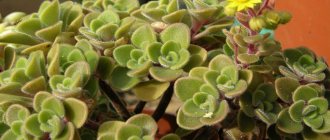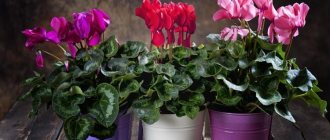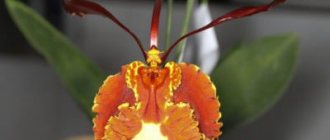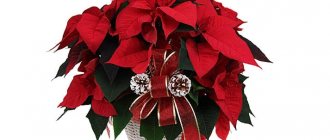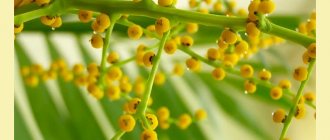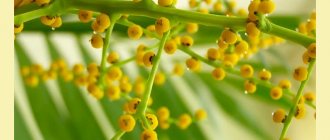- July 29, 2019
- Houseplants
- Natalia Miroshnikova
The Zamioculcas flower, also called the “dollar tree,” is popular among gardeners. This plant has an unpretentious nature; even a beginner can grow it if desired. In addition, according to signs, the flower brings good luck to the owners, and looks so attractive that it will decorate any interior. You will learn how to care for zamioculcas from our material.
Description
Zamioculcas, or dollar tree, belongs to the large family Araceae, and in its natural environment it can be found in the tropical mountainous regions of Africa and Madagascar. This plant is a herbaceous perennial with a tuberous rhizome and thick, fleshy roots, thanks to which it stores moisture.
Zamioculcas shoots reach up to 150 cm in height. They are densely covered with leathery, glossy, opposite, oval-shaped leaves with pointed tips. The plates are painted a rich dark green color, and perhaps that is why the plant received the second name “dollar tree”.
This succulent does not grow quickly, and it only adds a few leaves per year. But with proper care at home, the zamioculcas flower lives up to 10 years. And if you provide it with comfortable conditions, it can delight you with flowering and produce a small ear of pale cream color.
Bloom
Zamioculcas Zenzi blooms with inflorescences; they consist of a spadix and a spathe, which appear at the very base of the leaves. The spadix is an inflorescence consisting of small flowers of light shades: milky, light cream or yellowish, which smell quite pleasant.
The flowers are heterosexual and are found in inflorescences separately from each other. Women's - from below, men's - from above. Between them there are sterile flowers, they create a zone of sterility. Its role is to prevent plants from self-pollinating.
When and how does it bloom?
The flowering period occurs in spring . First, a small peduncle is thrown out, and a light leaf appears from it, covering the inflorescence. The Zenzi flower itself is inconspicuous.
The blanket has the same color as the rest of the leaf blades. For this reason, the inflorescence is difficult to see. The cob is first directed upwards, a little later, as it ripens, the cob begins to lean toward the ground.
What do the fruits look like?
The inflorescence itself is inconspicuous; it is formed on a small fleshy stem.
Zenzi blooms rarely, and fruits appear even more rarely in the form of small brown berries, and the seeds practically never ripen completely .
Varieties
The following types of zamioculcas are grown at home:
- Zamioculcas zamifolia. The variety is valued for its compact size. And the height of a tree of this type does not exceed 60 cm.
- Variegated Zamioculcas. A species distinguished by bright green leaves with pointed tips, which are located strictly symmetrically on the stems. There are also white spots and stripes on the plates. The plant reaches up to 1.5 meters in height.
- Zamioculcas lanceolate. The variety got its name for its elongated leaves of an unusual shape. The plant reaches up to 1.5 meters in height, but there are also more compact varieties with shoots whose length does not exceed 60 cm.
- Black Zamioculcas. The variety is valued for its unusual color of leaves and cuttings. Initially they are green, but as the plants grow they darken and become almost black.
Each of these varieties will become an interior decoration. But for this you will have to make some efforts and create comfortable conditions for the plants.
Kinds
Zamioculcas has many varieties, both natural and selected. Therefore, even experts cannot always understand the names and do not know which plant to classify as this genus. Which one is real?
Zamielifolia (Loddigeza)
The root is a tuber from which 60-centimeter leaf plates grow, divided into 4-6 pairs of individual feathers. The leaves fit tightly to each other, forming a rosette. During the dry season, the plant sheds its upper leaves.
Zamifolia
This species is called the “dollar tree”. Dissected leaves can reach 1 m, has a tuberous root. It looks great in the interior.
Variegated (variegated)
Some leaves on the bush are completely green, while others give the impression that they have not been painted. All of them are pointed at the tips. It has a root tuber and waxy leaf blades. It grows up to 1-1.5 m. The guest from Madagascar is quite rare in home collections, except that you can see it in botanical gardens.
Zamico
It was bred by breeders relatively recently. It is small in size and has small, oddly shaped leaves.
Lanceolate
It was precisely these elongated leaves that the ancestor of Zamioculcas had. Previously it grew up to one and a half meters in height. Now a miniature variety has been developed - about 60 cm.
Black
In appearance it resembles zamifolia. But it is interesting because it has very dark, almost black leaves and cuttings. While the bush is young, it has salad-colored leaves, but with age they darken more and more. This example looks quite impressive.
As you can see, Zamioculcas do not require careful attention; it is enough to provide them with the necessary temperature, lighting, and air humidity. And then the flower will delight with its beauty for a whole decade, or even more. And with the appearance of this succulent, prosperity will come to the house.
How to care for Zamioculcas
The dollar tree is an unpretentious plant; caring for it will not take much time and effort. In order for the plant to take root and please with its decorative appearance, it is enough to carry out the following agrotechnical measures:
- watering;
- feeding;
- transfer;
- prevention of diseases and pests.
And it is also important to maintain humidity, temperature and lighting that suit the zamioculcas plant. How to care for the plant is described in detail below.
Important! Zamioculcas is a poisonous crop, so all agricultural activities should be carried out with gloves. This is especially true for transplantation and reproduction. In addition, it is advisable to keep the flower away from children and pets.
Medicinal properties
Like most tropical plants, Zamioculcas is poisonous. So measures should be taken to prevent pets and children from reaching the flowerpot and tearing off the leaves. If the plant juice gets inside the body, it can cause allergies.
But those who grow succulents, taking precautions, have never complained about their health. Moreover, the bush is capable of absorbing negative energy, so it makes no sense to refuse the flower.
Lighting
Indoor zamioculcas is a light-loving flower. Therefore, you can place the plant near a south window. True, if you just bought a flower, then gradually accustom it to direct sunlight, otherwise brown spots will form on the leaves. In addition, do not forget to shade the plant during the midday hours.
And also an eastern or western window sill is suitable for growing zamioculcas. But on the north side the flower will suffer from lack of light. And here its growth will slow down greatly. Therefore, if you want to grow a beautiful shrub on the north side, then provide the plant with additional illumination with a phytolamp. Moreover, keep in mind that zamioculcas needs 12 hours of daylight.
Features of growing zamioculcas at home
The conditions for growing a dollar tree are quite simple. You will find basic information in our infographic. Save it so you always have it on hand!
Zamioculcas loves light and warmth, so it will feel good on western or eastern window sills and balconies. You can place the flower on the south side, but then provide it with good shading so that burns do not appear on the leaves. The plant will survive on a northern windowsill, in the shade, but may lose its rich green color. In summer he will enjoy “relaxing” in the garden or on the veranda. In winter, Zamioculcas often lacks light, so give it a place on the brightest windowsill.
Temperature
Homemade zamioculcas is a heat-loving flower. And from spring to autumn, it is advisable to maintain the temperature in the room with the plant within +22...+25 degrees. Cooler conditions are allowed in winter. But it is worth remembering that the mark of +16 degrees is critical for the culture.
At any time of the year, it is also important to provide the zamioculcas with an influx of fresh air. Therefore, ventilate the room regularly, and in the summer you can even send the flower to the balcony or garden. But remember that the plant does not tolerate drafts well. Therefore, during ventilation, take the pot to another room. And when growing on a balcony or in the garden, choose closed places for zamioculcas, where there are no sharp gusts of wind.
Why is the plant called the flower of celibacy?
The question of why the zamioculcas plant (photo above) is called the flower of celibacy worries many novice gardeners or simple lovers of superstitions. There are a huge number of different rumors and speculations regarding this plant, the main one of which is that a woman who has this extraordinary flower in her home will never be able to get married. However, there is not a single scientific confirmation of this theory, but there are plenty of refutations. On various thematic forums and in videos you can find reviews from women who were growing cob flowers at home even before they found their betrothed, but were still able to get married.
Humidity
Zamioculcas easily tolerates the dry air of an apartment, and does not need spraying. However, it is advisable to wipe the leaves of the flower with a damp cloth once a week. Otherwise, dust will accumulate on them. And this will have a bad effect not only on the decorative appearance of the plant, but will also worsen its health, because dust will block the access of fresh air to the leaves.
In addition, it is recommended to give the succulent a warm shower once a month. To do this, take the flower to the bath, cover the soil with polyethylene and wash the leaves and stems under low pressure of water. Then wait for the excess liquid to drain, and only then return the pot to its usual place.
Watering
The dollar tree is a succulent, which means that this plant tolerates drought more easily than over-watering. But it is not recommended to allow the soil to dry out completely, because even in this case the flower may die. Therefore, you need to approach watering with extreme caution.
Moisten the flower rarely but generously. Between waterings, the soil in the pot should dry out by half its volume. After irrigation, be sure to drain excess liquid from the pan. As a guide, you need to moisten the soil 1-2 times every two weeks in summer; in winter, when the flower enters a dormant period, it is advisable to carry out this procedure once a month.
At any time of the year, to water Zamioculcas, use only soft and settled water at room temperature.
Zamioculcas should not get wet
You need to be careful not only with the amount of water and frequency of watering, but also with how it is carried out. Zamioculcas should not be watered directly at the root, hitting the leaf petioles with a stream. It is carelessness when watering that most often leads to the loss of a dollar tree due to rot. It is more appropriate to water along the very edge of the pot, slowly and carefully, to protect the plant even from droplets of water.
And, of course, zamioculcas, thanks to their water-storing tissues, can easily tolerate dry environments. They do not need to increase air humidity by any method, especially by spraying. Showering and washing are especially not suitable for this plant.
Zamioculcas do not need to increase air humidity by any method, especially by spraying
Top dressing
Zamioculcas responds well to the application of fertilizers, acquiring a chic appearance. To achieve this, fertilize from February to October once every 14 days. Use mineral compounds intended for cacti and succulents. But use only half the dose indicated on the package. In addition, it is advisable to alternate mineral and organic fertilizers. As the latter, you can use nettle infusion or bee droppings solution. And also remember that you can apply fertilizer only after watering. Otherwise, the drugs will burn the tender roots of the plant.
Once a month it is advisable to carry out foliar feeding. To do this, spray the leaves of zamioculcas with a urea solution or complex fertilizer.
In winter, the plant does not need fertilizing, so eliminate all fertilizers at this time.
When is it better to replant, in what pot and soil?
The transplant is done in the spring, carefully selecting the right size pot . It should not be too spacious, otherwise the plant will engage in active tuberization, and new shoots will have to wait forever. Suitable soil: mixture for cacti and succulents.
Read more about when to replant a currency tree and how to plant it correctly.
Transfer rules
With proper care at home, the Zamioculcas flower grows well. And he feels cramped in the old potty. Therefore, it is impossible to do without a transplant. For young flowers, hold this event every spring. Replant adult specimens as needed, approximately once every 2-3 years. But at the same time, change the top layer of soil annually.
The plant prefers loose, breathable soil with a neutral reaction. A store-bought mixture for cacti or succulents will suit him. If you want to make soil for zamioculcas yourself, then mix the following components in equal proportions:
- leaf soil;
- peat;
- turf soil;
- sand.
Be sure to disinfect the substrate so that the plant does not die from microbes and pests living in the soil. To do this, heat the mixture in the oven or hold it over steam. As a last resort, spill the substrate with potassium permanganate. In addition, to increase the looseness of the soil, add a little fine expanded clay to the mixture.
As for the pot for Zamioculcas, the material does not play a special role here. And both clay and plastic flowerpots are suitable for flowers. The main thing is to remember that this plant grows roots slowly, so choose containers whose diameter is not much larger than the previous ones.
Why isn't it growing?
Sometimes it seems to the owner that the plant is practically not growing, and at the same time there are yellowed leaves. In this situation, you need to check the temperature, the presence of drafts and pests. It is possible that the breeder forgot to water the plant at the time.
Slow growth is a distinctive feature of this plant. Don't try to add more fertilizer or increase watering. If new shoots do not appear for a long time, it is worth reconsidering the location of the money tree and paying attention to the water with which the plant is watered. It should be clean and warm.
How to replant a plant
To prevent transplantation from harming the plant, follow the following algorithm of actions:
- Place a thick layer of broken brick, pebbles or expanded clay drainage at the bottom of the zamioculcas pot. Please note that this layer should occupy at least ¼ of the volume of the flowerpot. Cover the drainage with the prepared substrate.
- Carefully remove the flower from the old pot. To make this easier, moisten the soil first.
- Remove old soil and, if necessary, cut out soft roots and shoots that emit an unpleasant odor. Sprinkle the cut areas with crushed charcoal.
- Place the plant in a new pot and fill the voids with soil. Please note that the depth of planting the flower should be the same as before. After all, if you deepen the growing point of a plant too much, it will rot.
Water only after 1-2 days. This is necessary to ensure that moisture does not get on the injured roots, which can cause them to rot. And also for the first time after transplantation, keep the flower in partial shade. And only when the zamioculcas takes root, return it to its usual place.
FAQ
We have collected answers to questions that are most often asked by novice zamioculcas owners
Zamioculcas grows slowly, new shoots do not appear
If you bought a plant recently, then you shouldn’t be scared: it’s just getting used to the new microclimate.
In addition, Zamioculcas grows slowly in the wild: from time to time its growth may stop altogether for some time. Provide the plant with good lighting, select a spacious but not too wide pot, maintain the temperature and do not expose it to a draft. You'll see, he will soon respond to your concern, you just need to be patient.
How to Revive a Dollar Tree
Take it out of the pot, wash and separate the roots, cut off the rotten ones, then treat them with a solution of potassium permanganate, sprinkle the cut areas with activated carbon and plant in new soil. The plant should not be watered for some time after transplantation.
What to do if a branch breaks off
Don't be afraid of this. Just cut it off at the very base and sprinkle with activated carbon, crushed into powder. A broken shoot can be used to propagate Zamioculcas.
Pests
Generally, dollar tree poison will keep pests away from it. But with frequent mistakes in care, the strength of the zamioculcas weakens, and parasites begin to attack it. Most often, the flower suffers from the following insects:
- Spider mite. This parasite can be recognized by its sticky web, as well as white “fluffy” lumps that form on the inside of the leaves. In the early stages of infection, a soap solution or tobacco infusion will help get rid of the pest. If the insect colony is too numerous, then use insecticides, for example, Fitoverm or Aktara.
- Aphid. These parasites live on the inside of the leaves, and their activity causes the plates to dry out and curl. If you notice insects, immediately treat the plant with garlic infusion or soap solution. If this does not help, then use Actellik or Fitoverm.
- Shield. This parasite appears as slightly raised brown growths that can be located on any part of the plant. And also from the activity of pests, the zamioculcas turns yellow. What to do with pests? First you need to wash the plant with soapy water. And then you will have to remove the insects mechanically, using a cotton swab dipped in alcohol. Subsequently treat the plant with Aktara or Karbofos. Please note that spraying will need to be carried out at least three times, with an interval of 7 days between procedures.
Plants need to be protected not from heat, but from hypothermia
Zamioculcas are often called the ideal plant for living rooms due to their ability to cope well with heat. The dollar tree is not afraid of the heat; it almost does not react to temperature fluctuations in the positive direction. But attention should be paid to the minimum permissible values and cold drafts, and zamioculcas should be protected from the cold by all means.
Zamioculcas will be able to survive a cold snap of up to 12 degrees, but if you do not want to watch yellowing leaves, it is better to limit yourself to room heat.
Problems and their solutions
If you often make mistakes in care, Zamioculcas at home begins to be capricious. And flower growers often face the following problems:
- The plant is very elongated. This is how Zamioculcas reacts to lack of lighting.
- Zamioculcas leaves turn yellow. As a rule, a lack of light leads to this phenomenon. To correct the situation, move the pot closer to the window, or provide additional illumination with a phytolamp. In addition, zamioculcas leaves turn yellow when overwatered. Remember that the plant is a succulent, so it is better to dry it out than to overwater it. So normalize irrigation, and the problem will solve itself.
- The lower leaves fall off. This is the plant's natural renewal process, so there is no need to worry about it.
- Spots appear on the leaves. This phenomenon can be caused either by exposure to a draft or by excessive watering or keeping it in cold conditions. Correct the situation depending on the cause.
- Roots and stems rot. This phenomenon occurs due to keeping it in a cold room and excessive watering. To save the flower, replant it in dry soil and place the pot in a warmer room. In the future, provide it with proper care at home, and the zamioculcas flower will definitely take root.
Features of caring for a houseplant
The main thing is to place the plant correctly: in such a way that there is plenty of sunlight, but does not fall directly on the leaves.
Important! The secret to the success of growing this shrub is poor watering. Most often it dies from waterlogging of the soil and rotting tubers.
We wrote in detail about the rules of care in separate articles. Read about how to properly plant, tie up, trim and feed zamioculcas.
Root division
This method is quite simple, but is only suitable for adult specimens. During the next transplant, carefully divide the plant into several parts using sharp and disinfected scissors. Make sure that each piece has enough roots and 1-2 stems of the plant.
Let the cuttings air dry for 2 hours and then plant them in individual pots. The size of these flowerpots should be 2-3 cm larger than the volume of the roots. And also don’t forget to put a thick layer of drainage on the bottom of the pots. In the future, provide the flowers with regular care.
Reproduction
You can get new plants in several ways:
- part of a sheet;
- cuttings;
- dividing the tuber.
You can use any of them.
Leaves
You need to take not one leaf, but a branch on which several leaf plates are attached. You should prepare yourself for a long rooting process. Perhaps the matter will drag on for as long as six months. If you have enough patience, you can start.
Prepare a perlite-peat mixture. Dry the twig after cutting. After 4 hours, treat with root and immerse in the soil mixture. Place an inverted glass jar on top. If this happens in the summer, you don’t have to build a mini-greenhouse.
Wait until the container with the leaf plate is filled to the top with roots, after which you can plant the sprout in the pot.
Rooting of the leaf can also be done in a glass of water. Just keep an eye on the liquid level, constantly adding settled water. When the sprout sprouts a new leaf, you can plant it in a permanent place.
Cuttings
To get a cutting, you should use the apical part of a flower 18-20 cm long, which is already 2 years old. Leave 6 leaves on the shoot. After a few hours, when the cut has dried, treat it in a growth stimulator and place it in the ground. Stretch a film on top, which should be removed from time to time to ventilate the patient.
By dividing the tuber
It is best for beginning flower growers to use this method. When transplanting zamioculcas, you can divide the plant into two parts with a sharp, sterilized knife. The tuber must be handled very carefully. Dry the cut areas and sprinkle with charcoal. Plant the halves in different flowerpots so that the tubers protrude slightly above the soil mixture. The bushes may become sick after such a procedure, but will fully adapt to the division after a few months.
Cuttings
This propagation method is not as simple as dividing the roots, but it can be applied even to young plants. To do this, cut one of the stems just above the soil level. Be sure to sprinkle the cut area on the mother plant with crushed coal so that the “wound” heals faster.
Cut the shoot itself into pieces so that each of them has a piece of stem with a leaf and a bud. Air dry these cuttings for an hour and then press them into vermiculite poured into plastic cups.
Water the planting generously and place it in a warm and bright place out of direct sunlight. Maintain a temperature of +25 degrees near the plants, and do not forget to regularly spray the vermiculite with warm water from a spray bottle. But don't go too hard, and remember that this material should be damp, not wet.
In such conditions, cuttings will take root from 2-3 weeks to a month. When the plants are strong enough, transplant them into small individual pots and then provide them with regular care.
Trimming
Pruning is not a prerequisite for proper plant care. It is carried out only to give it a certain shape or rejuvenation. You can trim any part of the plant: tuber, leaves, cuttings. The main thing is that the pruning tool is very sharp and sterile. A scalpel, garden pruning shears, and a sharp knife will do.
Also read: Delosperma - a flower carpet in the garden! We grow at home and in open ground
The cut area must be sprinkled with crushed activated carbon. This will quickly stop the leakage and block access to the “wound” for pathogenic microorganisms. Often pruning is used to treat the currency tree.
Signs
There are many signs associated with Zamioculcas. For example, Feng Shui considers this flower a symbol of wealth and prosperity. And perhaps it received the second name “dollar tree” precisely because of this quality. Many owners even advise burying coins in a pot with a plant, and supposedly this will enhance its magical properties.
In addition, zamioculcas is considered a symbol of female happiness. According to signs, this flower helps ladies find their soulmate and also treats infertility. But in order for such qualities to work, the zamioculcas must be presented by someone, and preferably, it should be presented by a woman living in a happy marriage.
The flowering of this plant is considered a particularly positive sign. And if your zamioculcas has released an ear, then next year you will have good luck in all your endeavors. Alas, this happens rarely; to see flowering, you will need to make every effort.
In general, the dollar tree is an excellent choice for those who want to grow not only an attractive, but also a useful plant. Provide the plant with proper care at home, and the zamioculcas flower will reward you with rapid growth, a decorative appearance and will bring good luck and wealth to your home. To do this, adhere to the norms of agricultural technology and create comfortable conditions for the flower.
The main reasons for not releasing shoots and stopping growth
How Zamioculcas blooms at home
Experienced lovers of indoor flowers identify several problems due to which a succulent can stop its development. The list begins with hibernation and ends with the formation of root rot, which gradually destroys the crop.
Root rot
Adaptation after transplant
If zamioculcas no longer grows, then the primary sources of the problem are most often related to:
- With adaptation - the tree needs some time to get used to unusual conditions. Lighting indicators, soil quality and air humidity levels play an important role in its life. After the end of the adaptation period, the plant will rise again.
- With an incorrectly selected container - the total volume of the pot should not exceed the size of the root system together with the earthen lump by more than 3 cm. Strong deepening also leads to the cessation of development, all forces are devoted to the active formation of the underground, rather than the above-ground part - excess soil above the roots needs to be removed. If the problem is related to the inappropriate size of the container, then the culture is transplanted into smaller containers.
Important! At such a time, it is better not to disturb the tree again. Violation of the conditions of detention can become the root cause of a prolonged stay in a dormant state - for several years.
small pot
The plant has a dormant period
Another primary source of the lack of development is considered to be the time of rest in winter, which begins in November and ends in February. During this period, you need to stop watering it, stop feeding it, and send the container to a cooler room, with a temperature of a maximum of +15 degrees.
Under these conditions, the dollar tree will not send out fresh shoots, but no steps need to be taken. Features of the culture include slow development, with the appearance of several branches throughout the year. Active development of the crop is observed in the spring-summer period.
Mistakes made when caring for a flower
If zamioculcas grows poorly, what needs to be done: before starting rescue procedures, the flower is carefully examined. The initial examination allows us to draw conclusions about the source of the problems:
- Wrinkling, yellowing, drying or rotting on the leaf blades indicate that the tubers are affected by root rot. The problem is due to excessive overflow and poor drainage. The tree does not tolerate excessive soil moisture, preferring a slightly dry substrate. Watering is carried out no more than 1-2 times a month and only after checking that the soil is sufficiently dry.
- Drying of the tips of the foliage indicates a low level of atmospheric humidity in the room. The deviation occurs in winter, when central heating radiators are operating. The plant requires regular spraying and wiping the green part with a damp cloth.
Yellowing of foliage
- Lack of soil - the gradual growth of the root system provokes the fall of leaves and their yellowing. To avoid this situation, replanting work should be carried out annually or every two years.
- An excessively thin stem, blanching of the leaf blades and the tree stretching upward indicate insufficient light. Culture makes high demands on this parameter - it initially grew on the territory of African states. The container is moved closer to the light source, but not left in direct sunlight, which can lead to serious burns of the foliage.
Important! If the tree is constantly on the windowsill, it may go into hibernation or become seriously ill. After the air temperature outside has dropped to +15 degrees, it is removed and returned to its usual place no earlier than spring warming.
Pest attack
Infestation by parasites or diseases is also considered a possible source of stopping the development of a crop; in the absence of treatment, the bushes may begin to die. To confirm the theory that has arisen, it is necessary to examine the green part of the zamioculcas, paying special attention to the leaf plates on both sides.
Common pests include:
- Scale - sticky spots appear on the green part of the crop, the surface of which rises slightly above the foliage. Treatment begins with mechanical cleaning with a cotton pad soaked in a soap solution, and ends with thorough treatment with an insecticide solution.
- Thrips - identified by a silvery or pale coating on the leaf blades. Aktar, Inta-Vir and Fitoverm will help you get rid of uninvited guests.
- Aphids - curling of leaf blades occurs due to the absorption of their juices by small dark gray or greenish insects. Parasites nibble on the skin and actively suck out the liquid part. Their active reproduction is suppressed with the help of Decis, Fitoverm, Inta-Vir.
Defeat by scale insects
- Spider mite - the attack can be identified by the whitish coating that predominates on the underside of the foliage. Primary treatment consists of wiping the plates with a cotton pad soaked in a soap solution and spraying the green part with it. If a massive defeat occurs, then use Actellik, Demitan, Fufaron, Neoron, Fitoverm. Medicines against insect pests are bought at any flower shop and used strictly according to the instructions specified by the manufacturer.
- Mealybug - the formation of non-standard formations in the axils of leaves or on stems that look like lumps of cotton wool indicates an attack by this insect. The plant is removed from the box and the roots are examined - parasites often make nests in them. Treatment consists of using a solution of Actellik, Fitoverm and Inta-Vira and thoroughly spraying the tree.
Important! Antiparasitic substances must be used in compliance with safety precautions. Cleaning is carried out out of the reach of pets and children, after which the room must be thoroughly ventilated. Violation of the requirements can lead to serious poisoning - all drugs are included in the subgroup of toxic substances.
Development of diseases
Before asking the question of what to feed zamioculcas to accelerate its growth, you need to make sure that the tree is absolutely healthy and not sick. Common succulent diseases are:
- Anthracnose - refers to a type of fungal infection that provokes darkening of the stem and leaves. Requires repeated treatment with fungicidal solutions.
- Root rot - determined by wrinkling of leaf plates that begin to turn yellow, instability of shoots, and signs of general wilting. The cause of the disease is the same - overflow. To clarify the diagnosis, the diseased tree is removed from the pot and the root system is carefully examined. Rotting roots confirm this, while old and blackened ones indicate age-related changes.
- Stem rot - manifests itself as black spots on branches and foliage. Pathology occurs as a result of excessive moisture of the substrate.
When checking the root system, gardeners are faced with the phenomenon of drying out. The anomaly is associated with insufficient moisture of the substrate or too small a container, which interferes with the normal development of roots. In the first case, the frequency of watering is increased, in the second, large containers are purchased and replanted.
Important! Some varieties of money tree have dark purple specks on the foliage, which are not a symptom of the development of pathology. They belong to the normal state of the flower and do not threaten its health.

